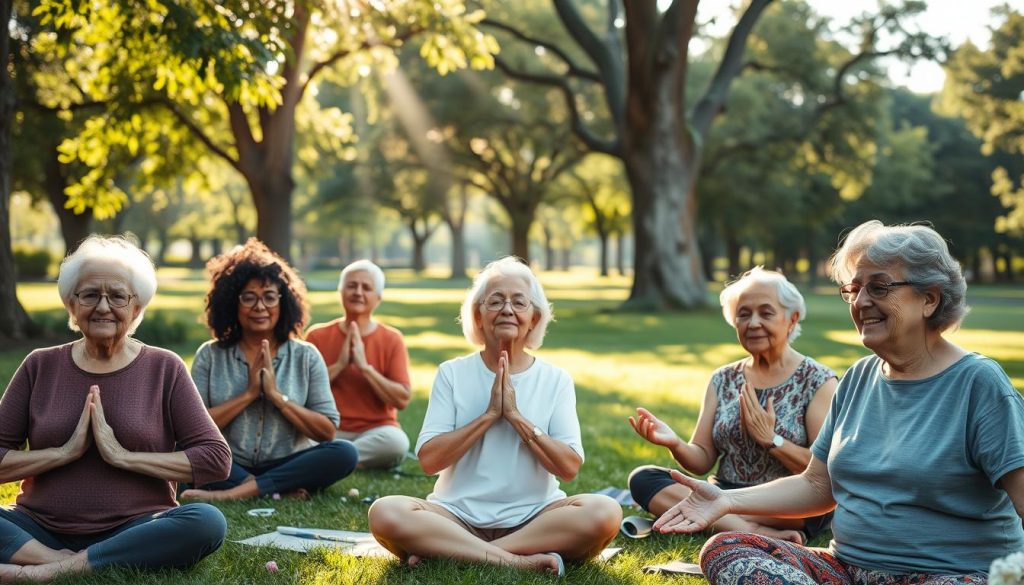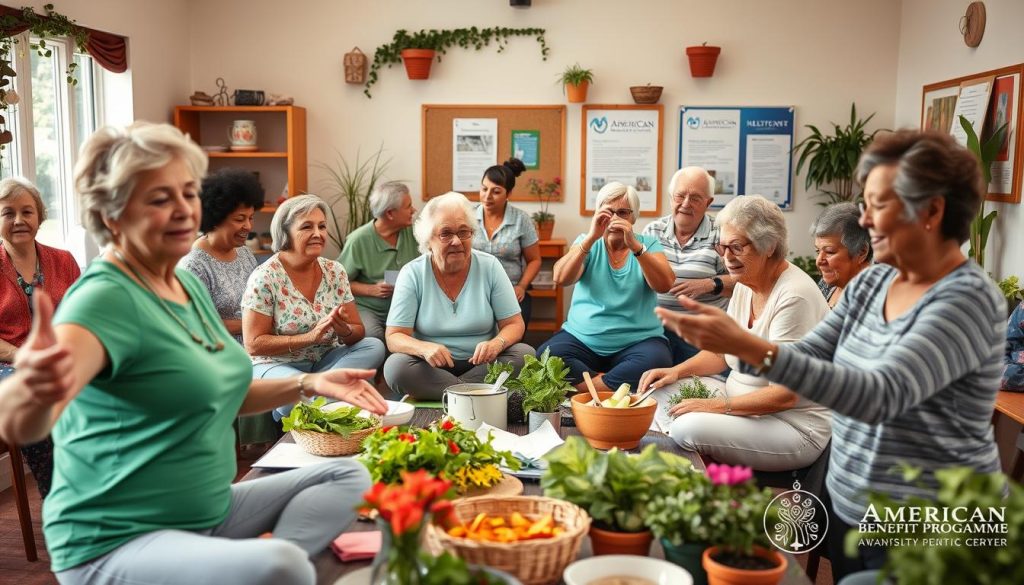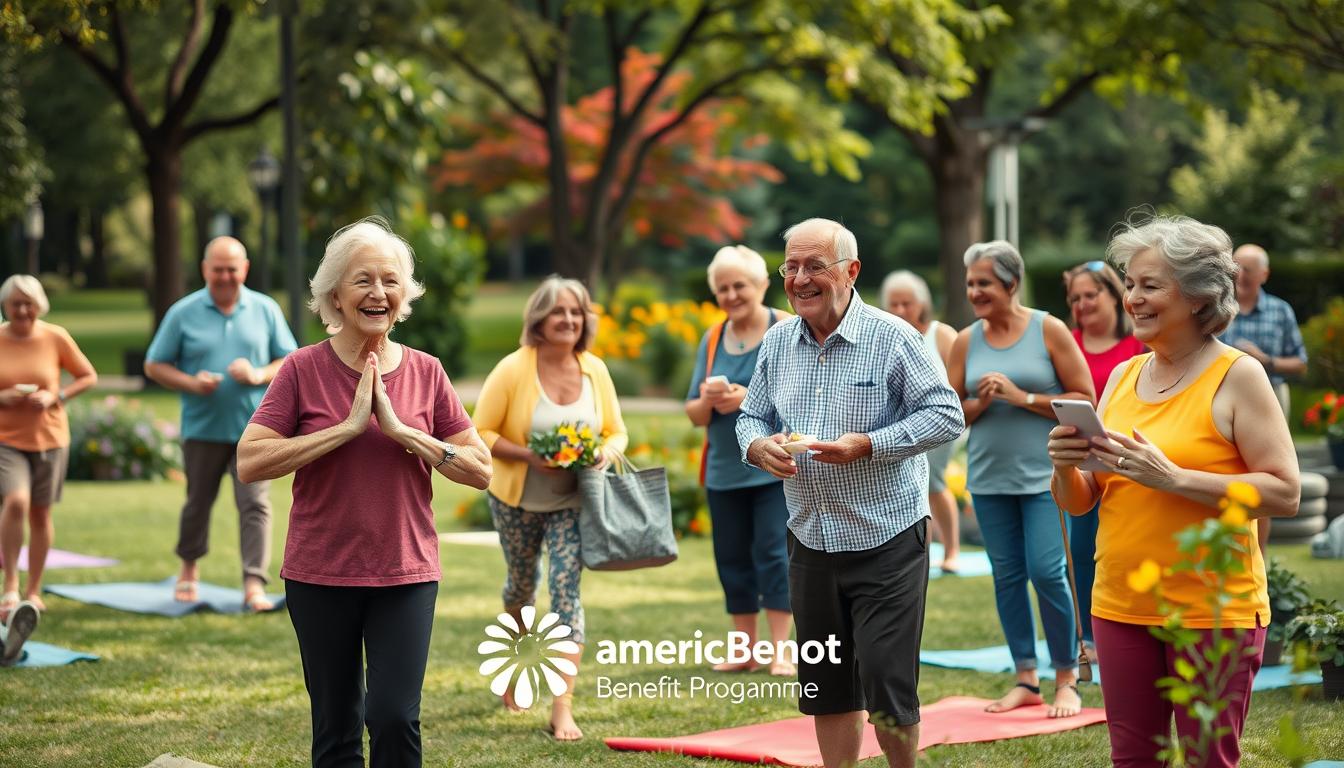Are we doing enough for our aging population? Projections show over 78 million Americans will be over 65 by 2040. Senior well-being programs are crucial. They aim to improve life for older adults physically, mentally, socially, and emotionally. There are more than 10,000 senior centers nationwide. They are key in making life better for local seniors1. We need to explore elderly wellness services. They help seniors stay independent, enjoy social life, and enhance wellness.
Key Takeaways
- Senior well-being programs are essential for improving the quality of life for older adults.
- Over 10,000 senior centers nationwide play a significant role in supporting elder wellness.
- These programs help promote independence among seniors.
- Social engagement opportunities provided by these initiatives significantly reduce feelings of isolation.
- Understanding personal needs is crucial to selecting the appropriate senior wellness services.
The Importance of Senior Well-Being Programs
Older adults need senior well-being programs to improve their lives. These activities offer mental and physical health perks. They help older people live longer2, studies say. Programs include health checks and education on staying healthy. This boosts their overall well-being2.
Enhancing Quality of Life
Well-being activities for seniors help fight loneliness. About one in three seniors living alone feel lonely2. These activities lessen doctor visits and falls2. They make seniors happier and healthier, cutting the risk of heart trouble and diabetes3.
Seniors doing these activities think and remember better, which matters as they age3. Feeling happy and purposeful makes it easier to deal with life’s ups and downs4.
Promoting Independence
Senior health programs help elders manage their own health. They boost activity and connect people through events3. Being social creates friendships and life satisfaction3. Brain games slow mental decline, keeping minds clear2. These programs show how vital they are for a good old age.
What Are Senior Well-Being Programs?
Senior wellness initiatives are programs to help older people feel better. They aim to teach health tips, connect people, and offer fun activities. These programs look at many parts of well-being to help elders.
Definition and Objectives
These programs help older folks live healthier and happier lives. They provide activities and resources for physical, mental, and social health. For example, the Turner Senior Wellness Program offers lots of great, cheap resources. This helps both old people and their families5. They work with other groups like Michigan Medicine to help meet elders’ needs5.
Types of Programs Available
There are many types of senior wellness programs. They’re found at community centers, places where retirees live, and healthcare spots. You can find Meals on Wheels, social events, and mind games5. Big organizations like AARP and Wellthy offer many programs6. These resources focus on keeping fit, staying sharp mentally, and feeling emotionally supported.
Physical Wellness Programs for Seniors
Wellness programs are key for seniors to live well. They help with strength, balance, and moving around. Everyone at any fitness level can join and get better.
Exercise and Fitness Initiatives
Programs like the Turner Senior Wellness Program stress exercise’s value for older adults. They offer activities such as balance classes, yoga, and tai-chi. These activities keep seniors healthy while fitting different needs5. Sadly, few older Americans do enough aerobic activities. It’s vital to create easy exercise plans to get more seniors moving7.
Strength Training and Balance Programs
Strength exercises stop seniors from falling. Most seniors have health issues that exercise can help prevent7. Focusing on resistance training improves their health and independence.
Aerobic and Cardiovascular Activities
Walking, cycling, and water aerobics boost heart health. But, not many seniors do these activities enough. We need community programs that encourage both kinds of exercises7. Adding healthy living tips, like cooking healthily, makes these programs even better5.
Mental Wellness Programs for Seniors
Mental wellness programs help in boosting brain health for seniors. They include fun activities for brain exercise. This improves the health programs for older people.
Cognitive Stimulation Strategies
These programs use puzzles, memory games, and fun tasks to challenge the mind. They help in memory and solving problems better. Joining these programs regularly keeps seniors’ minds sharp.
Memory Enhancement Techniques
Techniques like mnemonic devices help seniors with memory issues. These methods help them remember better. This lets them enjoy daily activities more. Creating a supportive place for these techniques is key.

Mindfulness and meditation lower stress and boost mood. With the right help, seniors deal with brain challenges well. They feel proud and happy8.
Social Wellness Programs and Their Benefits
Social wellness is key for older adults. It greatly affects their life quality. Being social boosts mental health and happiness. Studies prove that seniors in group activities feel better emotionally9. Senior centers are important for bringing people together with varied activities.
Senior Centers and Community Engagement
These centers let older adults meet, join in fun classes, and learn new things. For example, the LivWell program at Stonebridge at Montgomery offers wellness plans. These plans are made by trained staff for every resident’s needs10. They also have walking paths and gardens, helping everyone get involved11.
Group Activities and Social Interaction
Group events help seniors make friends and build support networks. At Stonebridge at Montgomery, there’s a lot to do like water workouts and lectures10. These activities build connections and keep minds sharp. They also help seniors grow personally, keeping their brains active9.
| Activity Type | Description |
|---|---|
| Educational Workshops | Classes that promote learning and personal development. |
| Recreational Classes | Activities that encourage physical fitness and social interaction. |
| Support Groups | Meetings that provide emotional support and camaraderie. |
| Group Fitness | Activities such as aqua aerobics to enhance physical health. |
| Cultural Events | Opportunities for social engagement through performances and lectures. |
These senior well-being plans better older adults’ lives. They promote connections and emotional health, which are crucial for seniors.
Emotional Wellness Programs for Seniors
Emotional wellness programs are key for seniors’ mental health. They help improve mental clarity and emotional balance. They give vital tools for dealing with aging challenges12.
Mindfulness and meditation reduce stress and make seniors more aware of the now. Doing activities like deep breathing, yoga, and meditation helps a lot. Being active keeps the stress away, boosts brain power, and fights off memory loss12.
Mindfulness and Meditation Workshops
Mindfulness workshops teach calming techniques. They make seniors feel better overall. Through these workshops, seniors learn to stay positive. This is crucial since about 14% of seniors struggle with mental health issues due to loneliness13.
Support Groups and Emotional Support Services
Support groups provide a safe place for sharing. They build strong friendships that help fight loneliness. Feeling lonely can be as harmful as smoking 15 cigarettes a day12.
Emotional support services boost older people’s well-being. Many seniors feel alone, affecting a quarter of them. Keeping a gratitude journal helps seniors track and lift their mood. This empowers them to manage their feelings better.
How to Choose the Right Senior Well-Being Programs
When picking wellness programs, seniors must look at their needs and goals. Things like health, thinking ability, and liking for social activities are key. By knowing what help is out there, they can choose what fits them best.
Assessing Personal Needs and Goals
It’s important for elders to know what they want from a wellness program. Goals can be getting more fit, boosting brain health, or making more friends. The Area Agencies on Aging (AAA) have been around since 1973 to support those 60 and older. They help older people stay in their homes and be part of the community14.
Evaluating Program Quality and Suitability
Seniors must look at who runs the program and their skills. They should check staff qualifications, feedback from participants, and how the program is set up. The Senior Information & Assistance service gives free help and advice to those aged 60 plus. This ensures they get the help they need for a healthy life14.
Places like the King County Senior Center Network have many resources. They help seniors find what they need in their area15. It’s good for seniors to use these chances to keep healthy and happy.
Resources for Senior Wellness Initiatives
Finding the right help can make life better for older adults. There are many groups and networks built to help seniors. They give services and help connect people in their communities.
Community Organizations and Support Networks
Many groups focus on what seniors need. For instance, AARP helps almost 38 million people stay active and fight old stereotypes about aging6. Places like Wellthy help over 2 million people with health care for seniors6. They also help with meals to ensure a healthy diet16.
Online Tools and Local Programs
Seniors can find wellness programs online. Platforms like FitPros create well-being programs for workplaces. MahaloLife helps caregivers with useful advice6. Online tools help find local activities to keep active. Programs that prevent falls are very important. They help seniors avoid injuries and stay independent16.

In short, local and health programs really help older people. Getting involved with these offers lets seniors manage their health. It lets them do things that make their lives better.
Success Stories: Senior Well-Being in Action
Many senior citizens feel better after joining wellness activities. They get stronger, happier, and make more friends. This shows how important such programs are for them.
Testimonials from Participants
Older adults love being part of well-being programs. One person said,
“Before joining the wellness program, I felt isolated. Now, I have friends and feel much more active.”
Many others also say these activities have improved their lives a lot.
Case Studies of Successful Programs
Looking at successful programs helps us learn what works. For example, senior centers help many by offering special wellness resources. They help from less than 100 to over 1,000 seniors17. They also teach people about the good senior centers do17.
Programs like CDSME help folks deal with long-term health issues. The Living Well Center has been great for veterans. It teaches and supports them18. Plus, some programs help people get back benefits they lost, showing how important these resources are18.
These stories show us how good senior wellness programs are. They also encourage more support for them. As more seniors live longer, staying active and happy is key19. Programs that look at both mind and body health are crucial19.
| Program Type | Benefits | Target Group |
|---|---|---|
| Chronic Disease Self-Management | Improved management of chronic diseases | Older adults with chronic conditions |
| Physical Wellness Initiatives | Enhanced physical health and social interaction | Seniors of all activity levels |
| Financial Assistance Programs | Recovery of lost benefits | Low-income seniors |
These stories help us see how senior wellness programs truly make a difference171819.
Challenges and Considerations in Implementing Programs
Setting up programs for older people comes with special challenges. It’s key to note hurdles like physical limits and getting around. About 58 million Americans are over 65. This number might reach 88.8 million by 206020. Issues like stigma or not knowing about these programs make fewer seniors join. This means they miss out on great health benefits.
Barriers to Participation
Older people face many hurdles when joining wellness activities:
- Physical limitations that hinder mobility and access.
- Transportation challenges, making it difficult for seniors to attend programs.
- Low awareness of available senior health programs within the community.
- Stigma associated with seeking help or participating in group activities.
Knowing these hurdles helps in making programs better. This ensures seniors get the help they need.
Strategies for Overcoming Challenges
To fight these hurdles, we can use many tactics:
- Adapt activities to accommodate various physical abilities.
- Provide transportation services to facilitate access to programs.
- Enhance outreach efforts to increase awareness of available resources and services.
- Collaborate with local organizations to broaden program accessibility and improve impact.
By using these tactics, we can get more older adults to join. This is vital as nearly 95% of them have at least one long-term health issue20.
| Challenge | Strategy |
|---|---|
| Physical limitations | Adapting activities to suit varying abilities |
| Transportation issues | Offering transportation services |
| Low awareness | Enhancing outreach efforts |
| Stigma | Community collaboration and support |
Conclusion
Senior well-being programs are key to keeping older adults healthy and happy. They help with physical and mental health. They also make sure seniors connect with others, which is very important. This is because nearly one third of seniors live alone. This can make them feel lonely21. As the number of older people is expected to be 72.7 million by 2030, we need to keep supporting these initiatives21.
To make these programs work, we need to look at what each senior needs. Since everyone is different, what they like and benefit from can vary. Making programs affordable, working with the community, and making sure there are rides available helps seniors join in22. But, there are challenges like not having enough resources or people to help. We must work on these issues to make sure the programs reach as many seniors as possible22.
Making sure we focus on mental, emotional, and body health will make seniors’ lives better. We aim for them to be self-reliant and joyful. This means thinking about the whole picture of care and including them in the community. This approach helps ensure our elderly live well every day. For more info on how these programs help, check out this resource. It has great information on promoting senior health.
Source Links
- National Senior Center Month 2024: Powering Connections
- Benefits of a Senior Wellness Program | VIPcare
- Why Are Social Activities for Seniors Important? | Lutheran Senior Services
- Participating in Activities You Enjoy As You Age
- Turner Senior Wellness Program
- Vendor List – Shortlister
- Aging Adults’ Preferences for Wellness Program Activities and Delivery Characteristics: A Cross-Sectional Survey
- Resources for Older Adults
- The Social and Health Benefits of Independent Living for Seniors
- Benefits of Senior Wellness Programs | Stonebridge at Montgomery
- Senior Wellness Programs: Acts Wellness Programs
- Emotional Wellness for Seniors: Everything You Need to Know | Sedgebrook
- Mental health of older adults
- Agencies That Help | DSHS
- Older adult services – King County, Washington
- Health, Wellness, and Nutrition | ACL Administration for Community Living
- As Senior Centers Evolve, So Do Their Challenges and Opportunities
- Success Stories | ACL Administration for Community Living
- Fostering Well-Being in the Elderly: Translating Theories on Positive Aging to Practical Approaches
- Get the Facts on Healthy Aging
- CDC Grand Rounds: Promoting Well-Being and Independence in Older …
- Community health promotion programs for older adults: What helps and hinders implementation

Leave a Reply